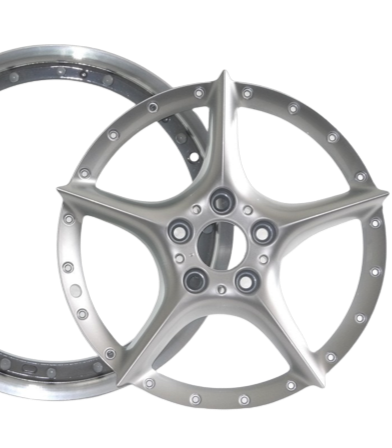top of page
STANDARD ALLOY
Alloy wheels are now available in an incredibly vast array of styles and in a variety of sizes, colours and finishes - matt, satin, gloss, painted, powder coated, diamond cut, polished, with plastic inserts, without plastic inserts... a great number of options! Regardless of finish, we refer to all aluminium alloy wheels - that are not split rims or imitation split rims (see below) - as standard alloy wheels.
STEEL WHEEL
Although less popular now than in the past, steel wheels can still be found on a selection of new vehicles, each year. A number of years ago, steel wheels - often covered by plastic hubcaps - were relatively common on a variety of newly-manufactured cars. Over the years, though, alloy wheels have become a more popular option for several reasons - one reason being that alloy wheels are notably lighter than steel wheels. Lighter wheels can positively impact a number of vehicle performance factors such as handling, acceleration and fuel-economy. As such, steel wheels are now mainly only found on newly-released heavier vehicles such as vans, trucks and buses. Although heavier, steel wheels are more resistant to chipping and cracking than alloy wheels. If they are damaged, however, steel wheels cannot be manipulated in the same way that alloy wheels can be. Possible repair-work is therefore very limited on a steel wheel.


SPLIT RIM
Split rim wheels can be separated into segments and can most easily be identified by the small bolts, around the rim of the wheel, which hold the segments together. The most common type of split rim is a 2 piece split rim. A 2 piece split rim, also known as a 2 piece wheel, can be separated into two segments - the barrel and the face. Though less common, 3 piece split rims are also in existence. 3 piece split rims, or 3 piece wheels, can be separated into three segments - typically the face and two barrel segments. For safety reasons, only a suitably competent and qualified individual should attempt to separate a split rim wheel into its segments or rebuild a split rim wheel. It may be possible, however, to carry out certain structural repairs or welding work without the need to separate a split rim wheel - depending upon the location and severity of the wheel damage.
IMITATION SPLIT RIM
Imitation split rims are single piece wheels that look like split rim wheels. Unlike 2 piece or 3 piece split rim wheels, single-piece imitation split rims cannot actually be separated into segments. The small false rim bolts are often plastic, instead of metal, and often cannot be re-used following removal. New replacement plastic or metal false bolts are therefore recommended if wheels are to be fully refurbished. Due to time constraints, it is the customer's responsibility to purchase and re-fit false rim bolts, following refurbishment. This allows us to continually provide a quicker turnaround. If an imitation split rim only requires structural repairs or welding though, without full refurbishment, it should not be necessary to remove the false rim bolts - depending upon the location and severity of the wheel damage.

bottom of page

%20no%20wheel.png)
